This interview is part of our interview series, where we curate stories of regular people that decided to design a life they love. (click here to learn more).
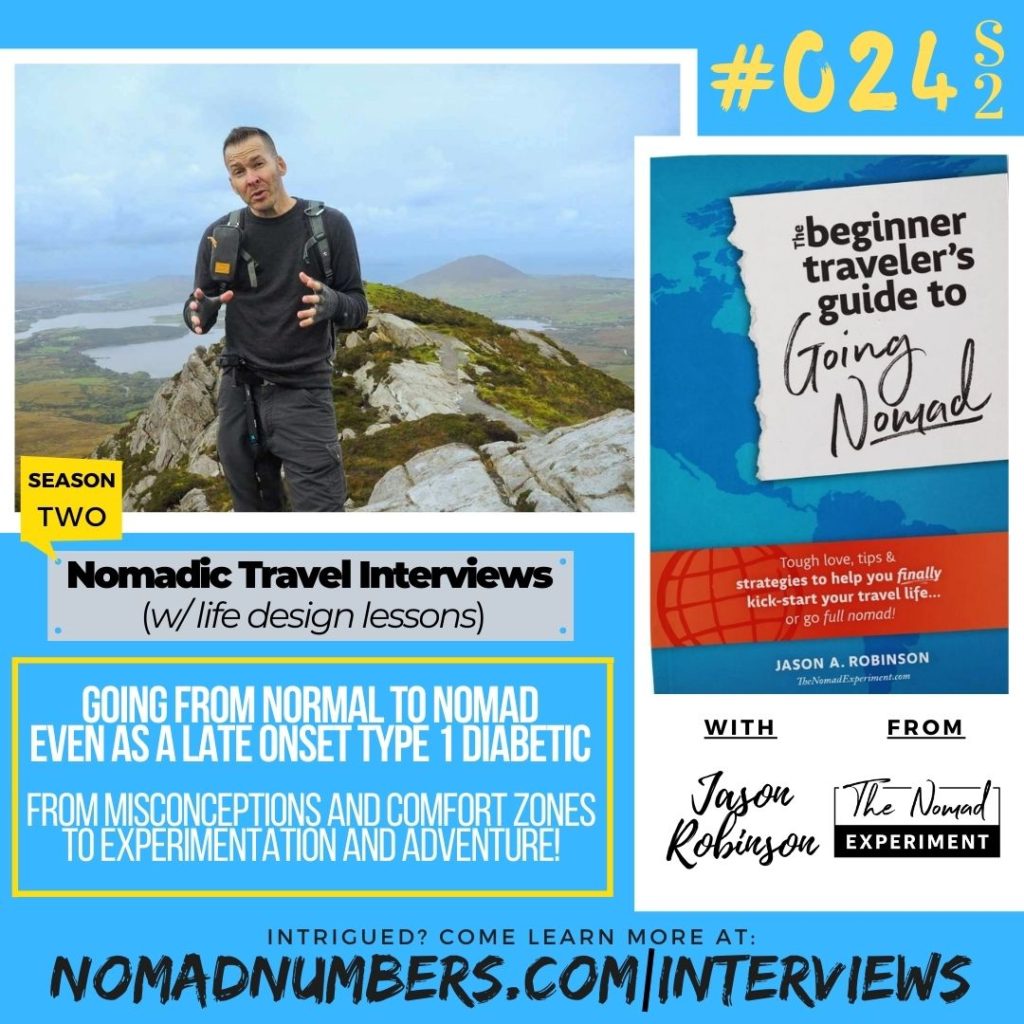
Jason Robinson from The Nomad Experiment
Some links to the products mentioned below are affiliate links, meaning that if you click and make a purchase, we (Nomad Numbers) may receive a commission at no additional cost to you. For more information please review our disclaimer page.
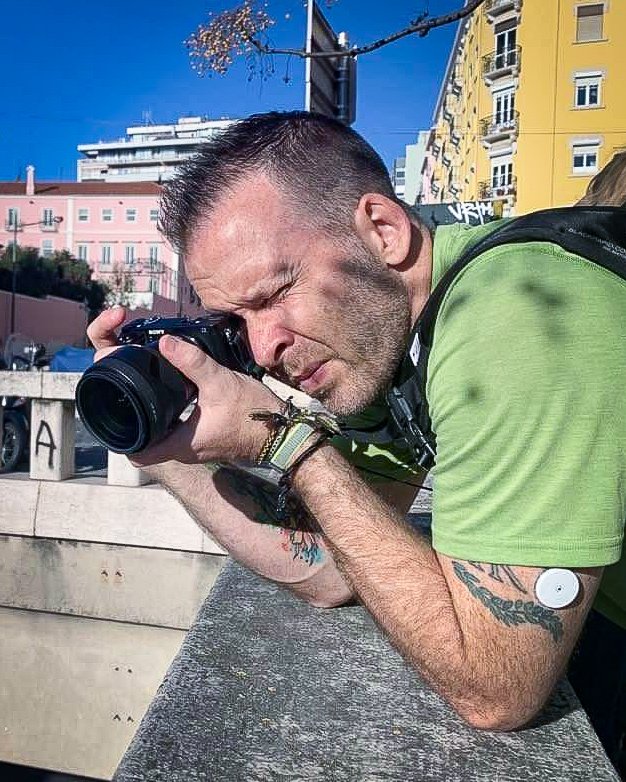
1. Can you introduce yourself?
Hello! I’m Jason, I’m 44 years old, and I like long walks on the beach and…wait. Seriously though, I was born in a small, working-class city in Ohio, spent my time after college in North Carolina, and now I’m nomadic, after selling everything just 8 months before Covid set in. But that quick of it doesn’t tell the whole story.
I grew up in a fairly small manufacturing/factory town in Ohio to a mom who stayed home and a dad who always took overtime to make ends meet. Travel wasn’t really a thing, and for the first 20 years of my life our trips were camping a couple of hours away or hiking. When in college I finally realized that I could move away from home, so I did afterward, at 24, to Charlotte, NC.
But being single and still pretty scared of travel, especially learning on my own, it wasn’t really until into my 30s that I started traveling more domestically and trying things like hostels. In my late 30s, I started really testing my limits, misconceptions, and comfort zone. But it wasn’t until my 40th year that I even saw my third country—Mexico. A year later I sold it all, 8 months later covid hit, then 6 months after that I was diagnosed with Type 1 Diabetes. So you could say the past few years have been pretty crazy!
Now I live nomadically and make a living as a graphic designer and writer/author, having just published “The Beginner Traveler’s Guide To Going Nomad” last year. Since I was barely catching a stride before Covid, it’s been quite a re-learning curve to get back out there and settle into living abroad and all of the mechanics of it!
2. What does a typical day in your life look like for you today? How does it differ from your life before?
A typical day for me starts early, as I’ve learned that’s when I’m most productive. I start working on design or writing projects and typically head out when I naturally slow down, around lunch. I spend 2-3 hours out exploring and eating, then work for a couple more hours at some point. I typically take a weekday off to spend the whole day exploring so I don’t have to wade through crowds on weekends. I use public transit and walking while abroad, so errands are slower and more enjoyable than being behind the wheel in a cage.
Note: Here is a side-by-side comparison of Jason’s life before/after
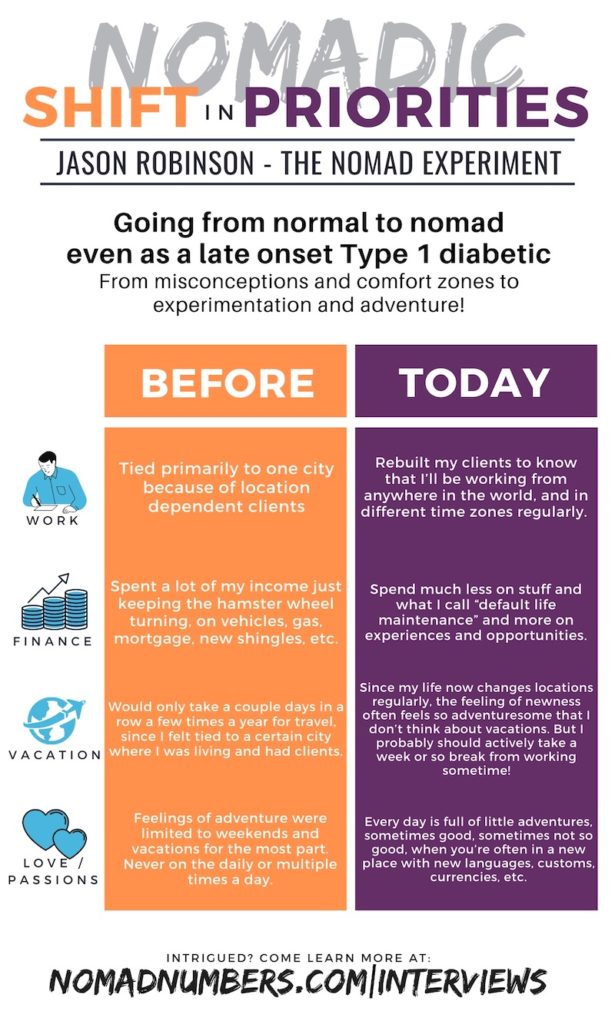
Life design journey
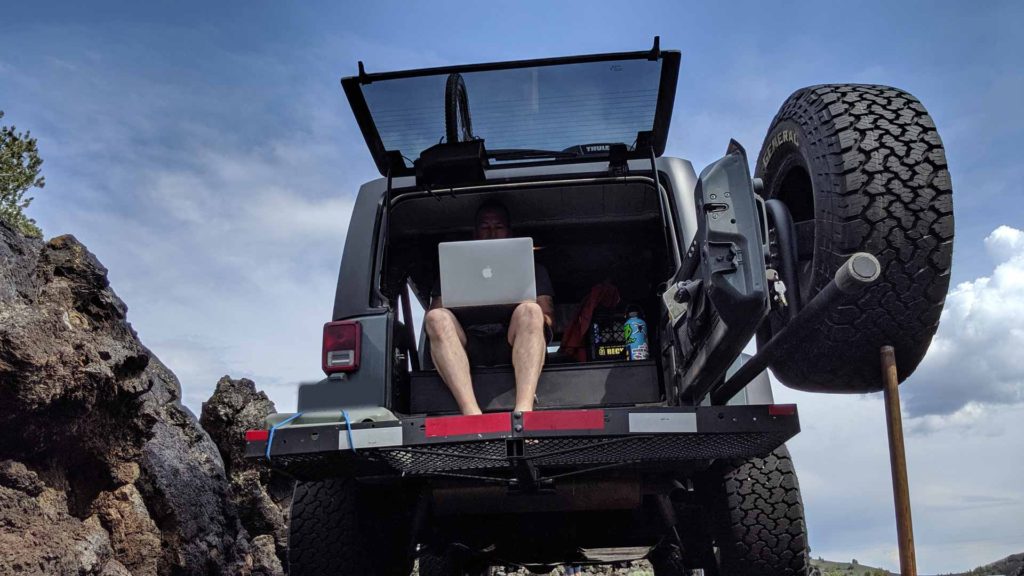
3 – What inflection point led you to decide to change your life trajectory?
Well, I had been working up to it, but it was literally February 15, 2019, and I learned that I not only needed a new roof on my house, but also a new HVAC unit, within the next year. As a single homeowner, the idea of spending $25,000+ on fairly um…boring stuff…was the last straw. Having really dug into travel the preceding two years, I realized that the house I was living in was no longer my happy place…being out traveling was. The house had become more of a stranglehold, so I decided to sell and it was no longer mine 3 months later—along with most of my other big worldly belongings!
4 – What were some of the limiting beliefs that hold you back initially?
Well, I had been working up to it, but it was literally February 15, 2019, and I learned that I not only needed a new roof on my house, but also a new HVAC unit, within the next year. As a single homeowner, the idea of spending $25,000+ on fairly um…boring stuff…was the last straw. Having really dug into travel the preceding two years, I realized that the house I was living in was no longer my happy place…being out traveling was. The house had become more of a stranglehold, so I decided to sell and it was no longer mine 3 months later—along with most of my other big worldly belongings!
5 – What did you do to prepare the transition to this new destination and how did you do it?
I was raised to believe that most of the world outside of the US was a big scary place filled with scary situations and people. I was also of the belief that travel was expensive. Neither of those is true, as everything is on a spectrum. Yes, you can find scary people and places, but you are much more likely to find the kind and awesome ones. And travel can be quite affordable, especially compared to what it actually costs to live as an American in the US.
6 – Once on the journey, what were some of the biggest wins you realized? What were the challenges you had to face along the way?
Well, being nomadic, whether in the US or in different short-term locations elsewhere, requires more personal and work-life flexibility, which is actually quite liberating and relaxing when compared to the frenzied pace of what life used to be. I stopped trying to have an answer…or a plan… for everything, and just concentrated on doing my best and having backup plans.
Getting diagnosed with Type 1 Diabetes at age 42—barely a year after going nomadic and in the middle of a pandemic—definitely added a big wrinkle! But I quickly came to the realization that people around the world are afflicted with the same things we deal with in the US, so I would be able to make due around the world one way or another. So now I make it a point to learn what my options are if I need medical supplies or in case of emergency wherever I’m going. And actually, so far I’ve learned that my costs are actually reduced significantly by not buying some of my supplies in the US.
Recently, on my first international trip since being diagnosed and late in covid, I had two of my insulin pens get frozen on the flight across the Atlantic—which rendered the insulin unusable. The flight attendant meant well, but didn’t realize that I was serious about not putting them anywhere that would freeze! Since I was planning to be in Portugal for three months, I had to find out how to get more insulin. But after hitting up a few pharmacies in different cities, I quickly started confirming what I had heard about medical costs in many countries outside of the US—things can be a lot less expensive than in the US. If I had to purchase the same insulin pens out of pocket in the US, it was hundreds of dollars. For the same amount in Portugal, it was under $60…without insurance!
I will say that finding places conducive to getting work done wherever I go is also paramount to reducing my stress level. Finding…and paying whatever is necessary…for a good, productive coworking space allows me to spend less time “figuring out how to work” and more time enjoying life. If you can’t pay the bills, it’s hard to enjoy the benefits of a new destination because the stress will eat at you. An old colleague once said “you have to spend money to make money,” and that has often rang true. Money issues will eat you up quickly, so put those at the top of your list to figure out ASAP!
7 – How long did/will it take to reach the destination? Any advice to make the journey as enjoyable as possible?
Well, that’s literally what the book is about—not rushing it. Especially for someone like me that never traveled much, there’s a lot of soul-searching, comfort-zone crushing, and other alliterative life-changing that needs to happen before switching over to a nomadic life. I was extremely calculated in my experiments for about five years before I naturally came to the conclusion that I was ready to be nomadic. I suggest everyone take it at their proper pace…but don’t stagnate…and realize that life is long. Even if it takes you 3-4 years to figure out if going nomad is right for you, you’ll still have a ton of life to live and experiences to fill it with—without the constraints you previously had. So you’ll get to do more faster when that time comes!
8 – What did the people around you (friends/family/colleagues…) think of your plan to take on this new life?
Initially, they were mostly freaked out and thought I was having a mental meltdown or something—which in all fairness, I may have been. A handful were super-stoked though. But I understand that even the ones that seemed off-put were simply concerned or so far outside of the idea that they couldn’t see the opportunity that I did. Eventually, they all came around, especially when they saw that I was serious and that my life was looking pretty rad from the other side! Now when I catch up with friends the conversations are longer because they keep the questions coming about my new lifestyle.
Cost of living
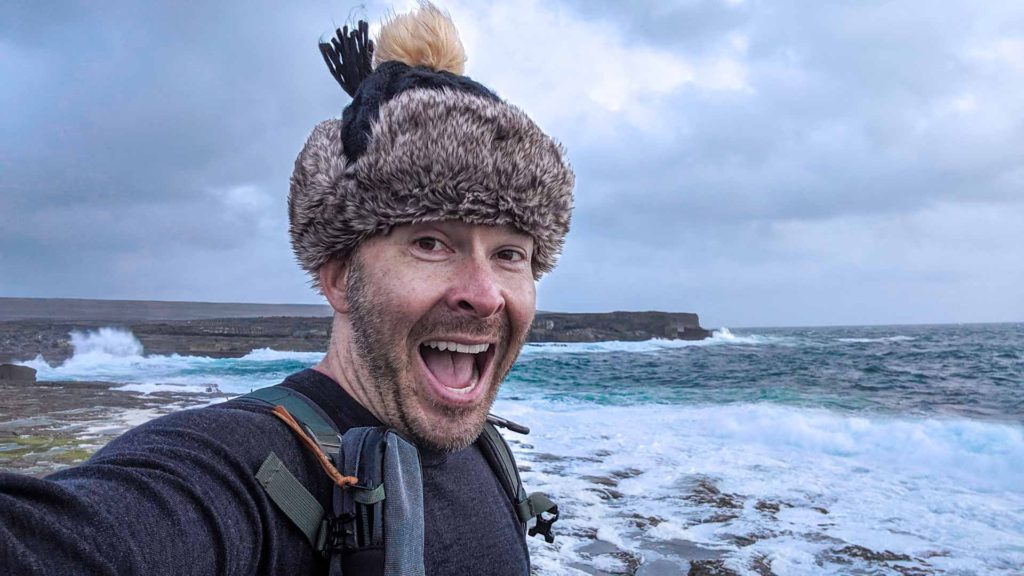
9 – How much yearly expense did you have before and after this change in lifestyle?
Well, there were years where I was making up to $85k a year and somehow spent most of it between mortgage, vehicles, and just untracked spending. That was in a fairly inexpensive large American city. And that included very little travel. But now my yearly spend is usually between $20-30k all-in, and that includes a life filled with travel and very little untracked or lost spending.
Honestly, I didn’t start tracking my spending until I was 28 and over $50k in debt. Over four years of hard work I paid that off and learned that one of the most important things for a balanced and stress-free life, for me at least, is a balanced and visible budget. Because the only “big expenses” I have in the US are still my Jeep (which I use to overland in the US sometimes) and health insurance, there’s just a lot less of those life maintenance costs. My healthcare costs have gone way up, but as I learn to travel with Type 1 Diabetes around the world, I’m confirming that it’s actually monumentally cheaper for me to get care abroad than in the US.
Note: here is a monthly breakdown of Jason’s expenses:
| Category | Description | Monthly Budget |
|---|---|---|
| Accommodation | Anything you pay toward keeping a roof over your head (ie. rent, internet, water, utilities…) | $600 |
| Alcohol/Coffee | Anything related to alcohol you purchase | $125 |
| Groceries | Anything related to the groceries you get to cook at home | $250 |
| Dining out / Take-out | Anything related to what you spend when dining outside of your home. | $150 |
| Activities / Entertainment | Anything you pay related to ‘fun money’ (ie. park fees, outdoor activity, AirBnB experience…) | $150 |
| Health Care | Any cost related to treatment you are receiving on a given location. | $200 |
| International Health / Travel Insurance | This is health.travel insurance that your purchase to get you covered outside of your home country | $35 |
| Local Transportation | Anything related to transportation within the boundary of the location you are staying at. | $100 |
| International Transportation | Anything related to transportation to go from one location to another. | $100 |
| Visa | Any cost related to a visa to stay in a given country. | $0 |
| Living expenses | Anything else that you are spending money on to live in a specific location that can’t fit anywhere else (ie. Haircut, Netflix, cell phone…) | $200 |
| Monthly total Yearly total | $1910 $22920 |
10 – What strategies have you used to reduce your expenses? And what strategies have you used to fund your lifestyle?
Well, travel/flight hacking is extremely helpful, since I rarely pay more than taxes or fees for most flights from the US. And since I prefer to stay abroad for long stints, I only actually need a couple of flights a year. Using a travel rewards card for all purchases nets me enough for those. I stay in hostels a lot, but also use mid- to long-term rentals when possible which come with reduced costs. Staying in less expensive countries is probably the easiest answer though. When things simply cost less you spend less, but often get so much more than the baseline in the US.
I’ve been a graphic designer my whole life, so I continue to use that as my paid profession. I designed the book, and I still work as a senior designer with my own clients and select design firms that need high-level design and strategic expertise. But the amount of hours I need to work is less than half of my previous life, so I’m able to spend other time writing or designing my own projects for TheNomadExperiment.com.
Lessons, tips & advices
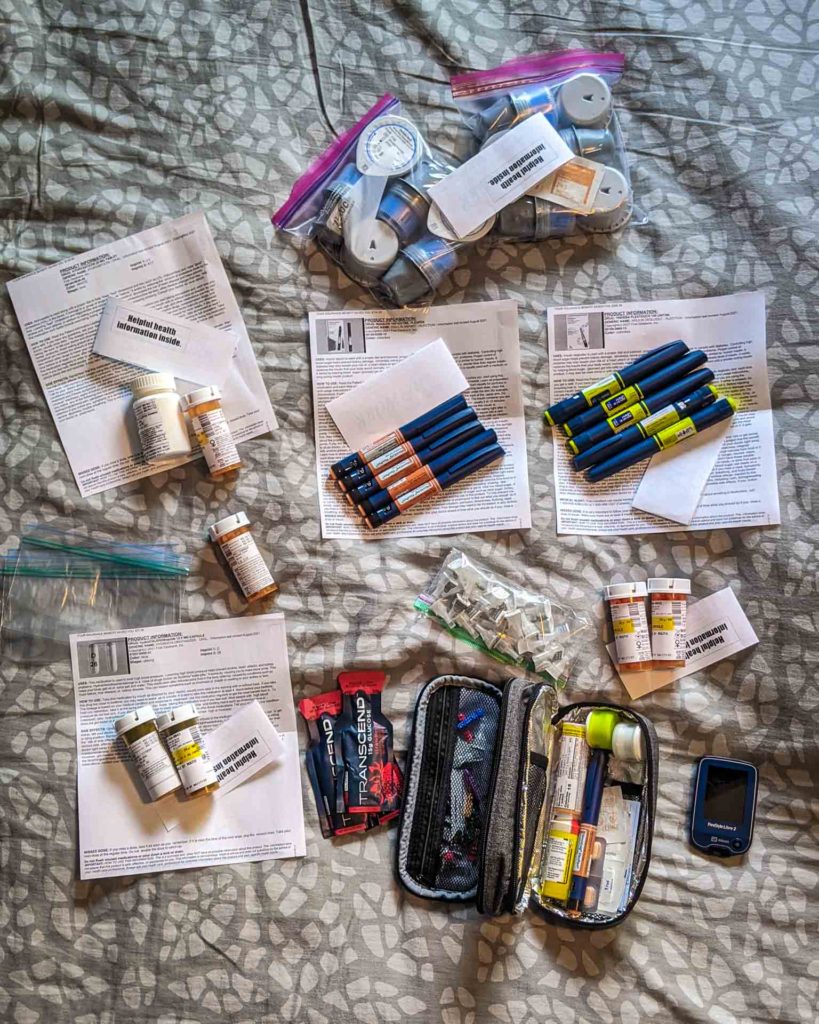
11 – If you had to do it again, what would you do differently?
I would absolutely do it earlier. I sat around knowing something else was possible for so long until I finally decided to start challenging and changing my status quo life. Fear of the unknown and other weak excuses caused me to stagnate for years. I’m not big on regret, but if I had it over to do again, I would have kicked myself into gear 10-15 years earlier. That said, I tell people that there’s never a “too late” time to start. Life is long, and even if it only takes a couple of years to make a transition, the amount of life packed into the years after the transition is exponential compared to the “typical” life.
12 – What advice do you have for others who are considering going through a life design exercise?
Well, I would be remiss if I didn’t start by saying, get “The Beginner Traveler’s Guide To Going Nomad” because it literally takes into consideration many of the mental, emotional, physical, financial, and travel-related hurdles you’ll have to deal with. There are a lot of changes that need to be taken into consideration, so simply thinking you can flip a switch and change your life is quite short-sighted. Then I would say take it at your own pace, but at the same time set up aggressive goals within a year. Once reached, set loftier goals. If at any point you realize the path you are on doesn’t feel right…for an extended amount of time…change it. But likely, after consistent comfort-zone-crashing, you’ll get to a point where everything seems easier and the choice to go all-in becomes the only choice that makes sense for you!
Don’t forget, you can almost always go back to what you’ve done, where you’ve been, or how you’ve lived, since you’ve done it all before. And you can likely do it better. But spending a year or two exploring new travel and life possibilities is going to potentially be more exciting and impactful than anything you’ve done in the past, especially if travel is fairly new to you.
13 – What is one resource (blog, podcast, book beside your own) you recommend for those that want to design their own life?
The LocationIndie.com community was a game-changer for me, as it’s a group of people across the US and abroad that are all trying to achieve the same goal; create a location independent life that allows them to make a living anywhere they want in the world. Having the support of others with the same mindset and goals is monumentally important to the success of any endeavor in life, especially when it goes against the mainstream and there are a lot of negative or contrary opinions thrown at you by those in your immediate circles.
Looking ahead
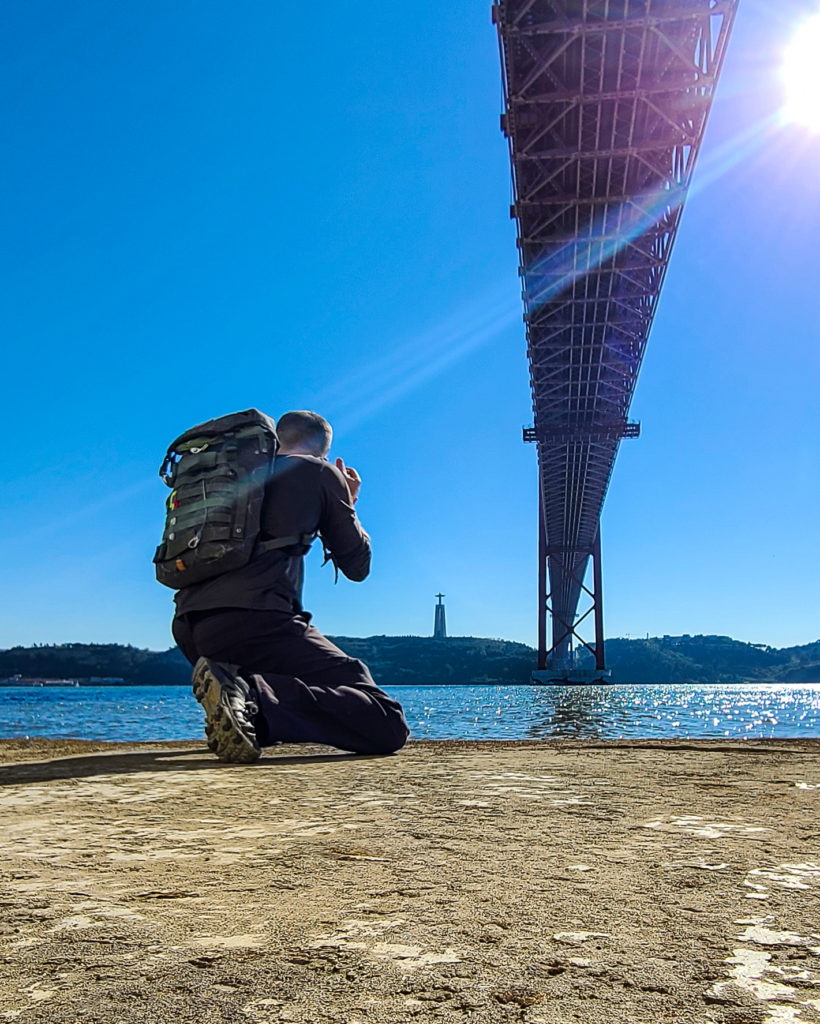
14 – What is next for you?
Now that travel is opening back up a bit, my goal is to be outside of the US at least 9 months a year. I still have to come back often for doctor’s appointments and to navigate my Type 1 Diabetes, as well as get medications, etc. As time goes on, I hope to be able to handle more of that while abroad, but right now I’m learning as fast as I can without putting too much pressure on myself to figure it all out at once.
I also haven’t been east of Hungary, and have actually still only seen about 10 countries. So continuing East is a big goal. Again, since I’m still learning and traveling solo, I’m not forcing myself into that, rather getting back in my groove with the nomadic life and will start pushing back outside of my comfort zone in the next few months as I catch my stride.
I also plan to try seasonal work for a few months next year, as it’s always been something I’ve wanted to try but have found excuses not to. Since my nephew demolished his comfort zone and did it, I guess I have to follow his lead and give it a try! So maybe work at a US National Park or a Ski Resort for a season to see what that life can be about. So many options!
I think in the end the hardest thing to remember is that life is a marathon, not a sprint. We tend to think that big decisions are much bigger than they are in the grand scheme of our long lives. When we can just say “well, let me give this a try for 6 months, or a year, and learn something…” then it frees us up to try things without feeling like we’re giving up everything we’ve had or done up until that point. That’s why I believe in the Experiment mindset. It allows us to just try things, fill in the gray areas in-between what we think we know or don’t know, then allows us to move on with more knowledge than before.
Thank you so much Jason for sharing your transformational life design journey with us. It is quite inspiring to see how far you’ve come and how you manage to travel the world while being a Type 1 Diabetic. That alone should be a great source of inspiration for people that have similar conditions and that never felt confident enough to move away from their comfort zone! As for now, we hope that you are gonna keep exploring many countries and be catching up on travel!
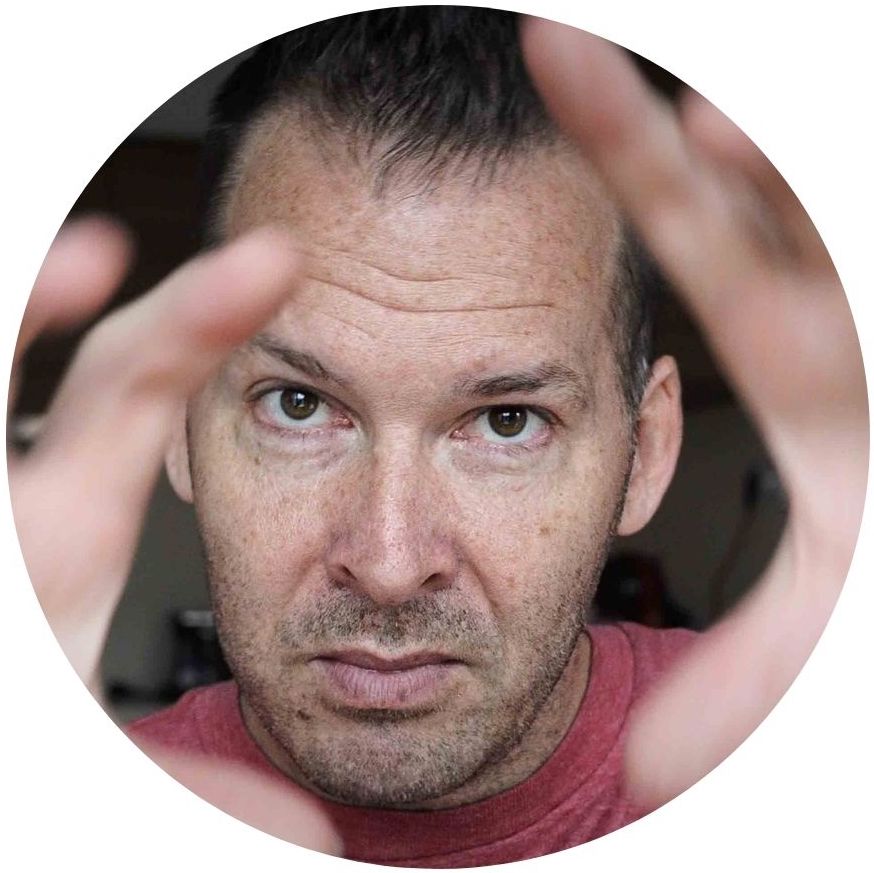
If you want to know more about Jason, you can find him on the following platforms:
- Blog:
- Instagram:
You can get the book, The Beginner Traveler’s Guide To Going Nomad, through his website or on Amazon. It’s available in proper paperback or digital.
Rapid-fire questions
We like ending every interview by asking some fun rapid-fire questions to our guests
| What is your superpower & why? | Overthinking. It makes me good at my job as a graphic designer and brand strategist, and also able to help friends and others see things from different angles to help them through spots. |
| What is your favorite travel destination & why? | Well, so far Mexico. The people, the food, the weather, the language…it’s all beautiful and I can’t wait to get back and settle in for a few months and continue to learn the language so I can connect even more with the people and experience a deeper connection with the country. That said…after three months in Portugal, there might be a new favorite rising! |
| What is the best Amazon (or online) purchase you made this past year? | This is a weird one, but it’s the camera sling for my DSLR. This thing has been a game-changer for me. |
| What’s something you can never live without? | Insulin? 🤣 |
| What’s the best piece of advice you’ve received? | “You have to just get out there and do it. You’re never going to be able to really know one way or the other until you go all in.” |
Our Bottom Line
Here are the main lessons we took away from this interview with Jason Robinson:
- Lesson 1 – “A nomadic life isn’t some magic pill” – The nomadic life is not the magic answer to happiness and fulfillment and it might not fit everyone. But the fact that someone becomes nomadic allows them to live with less, be more nimble and get to experience much more of the world, which tends to generate a great dose of new experiences that are usually tied with excitement.
- Lesson 2 – “If I had it over to do again, I would have kicked myself into gear 10-15 years earlier.” – People should reconsider their life and limiting beliefs and not be afraid to go out of their comfort zone and experience new things. This is what Jason did and what led him to embrace a travel lifestyle and adjust his work accordingly by becoming fully remote.
- Lesson 3 – “take it at [your] proper pace…but don’t stagnate…and realize that life is long. […] The hardest thing to remember is that life is a marathon, not a sprint” – Taking action is paramount to living and people that don’t take action are people that probably aren’t living their life to their fullest extent. By moving forward and taking incremental steps along the way you will get to be exposed to new things that will likely increase your overall fulfillment and reason to live.
Sometimes we need to hear about others making unconventional decisions before we can have the confidence to make our own. If you have (or are on a path to) an unconventional journey to improve your life that has a nomadic component to it and is interested to share it, please reach out to us as we would love to consider your story for our blog.
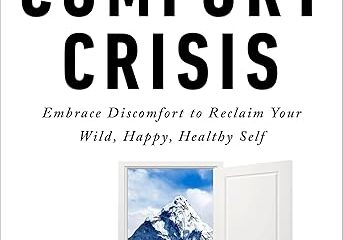
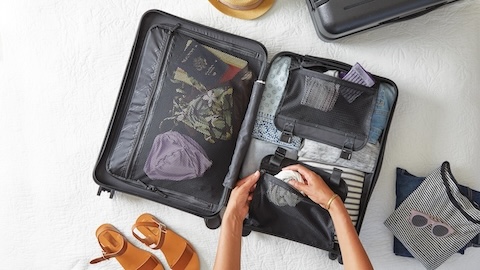
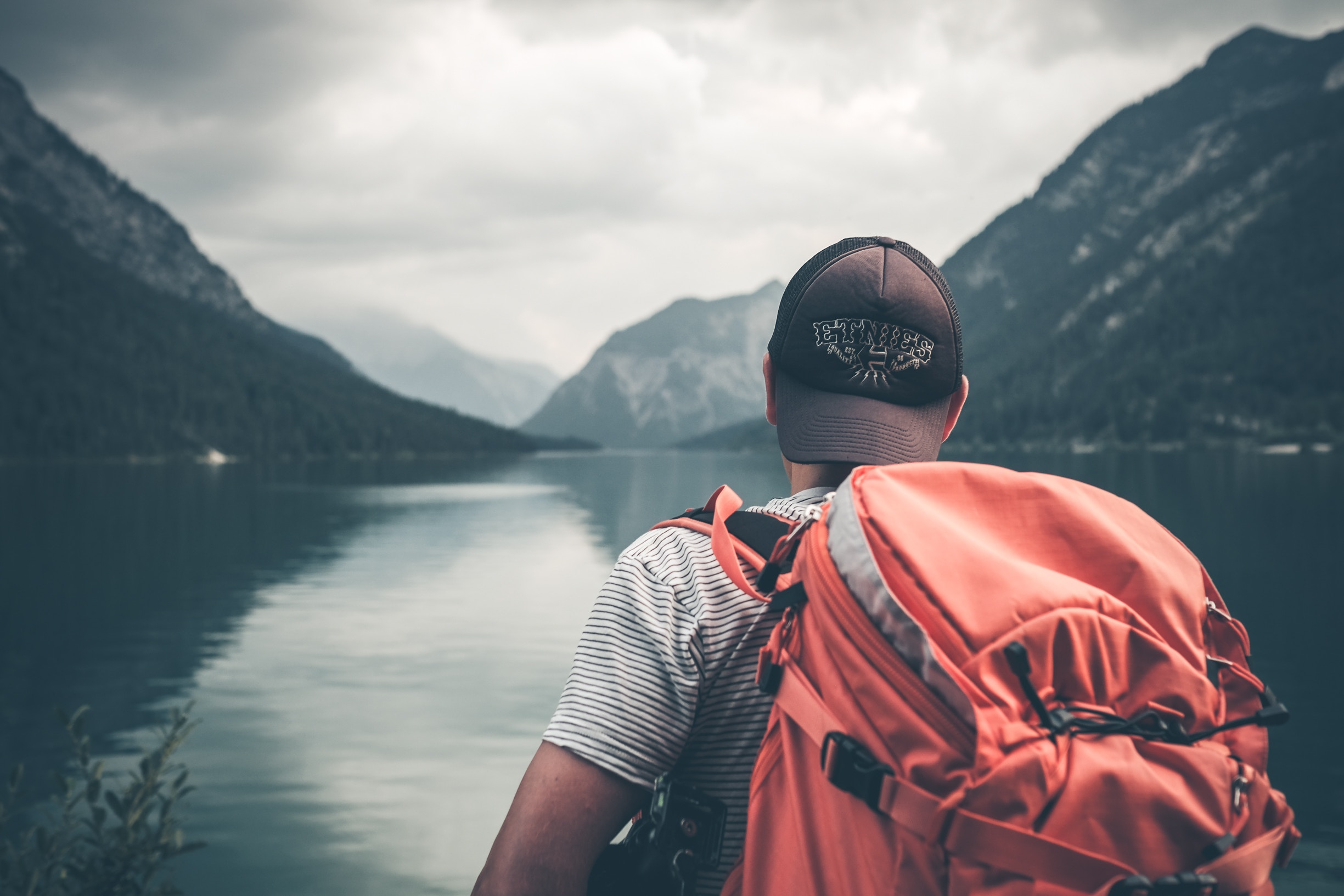
4 Comments
Veg · March 29, 2022 at 4:21 pm
Great interview!
It’s really helpful to hear from someone with a chronic illness that has to be managed while traveling.
Just so you know, I think the column headings (“Before” vs. “Today”) are reversed.
Also, Jason must have meant “east” when he wrote “I also haven’t been west of Hungary”.
Mr. Nomad Numbers · March 30, 2022 at 8:05 am
Thank you for the comment. I did fix the infographic and updated the article after confirming with Jason 🙂
Jason @TheNomadExperiment · March 31, 2022 at 12:03 pm
Such a good time working with you on this interview! Truly hope folks get something out of it!
Mr. Nomad Numbers · April 1, 2022 at 3:37 am
Thank you Jason for taking the time to share you story with our audience. It is truly inspiring and I hope it will help you connect with other like minded adventurers!